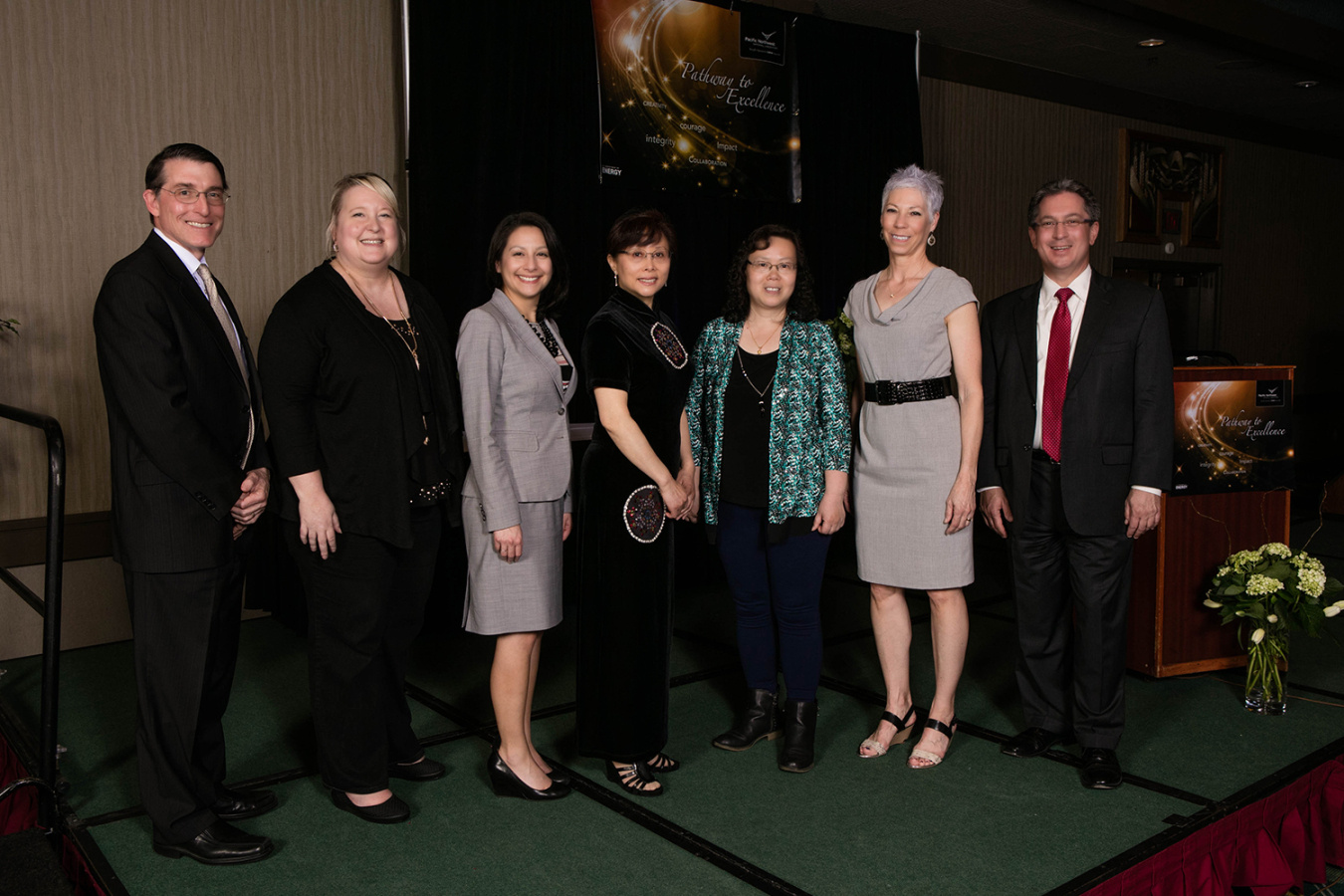
Awardees and distinguished guests at PNNL’s Pathway to Excellence Celebration are (left to right) Jud Virden, Associate Laboratory Director, Energy and Environment, Malin Young, Deputy Director for Science and Technology, Jetta Wong, Director for the Office of Technology Transitions, Shari Li, Distinguished Inventor of Battelle, 2016, Zimin Nie, PNNL's Inventor of the Year, 2016 Wendy Bennett, Distinguished Inventor of Battelle, 2016 and Steve Ashby, PNNL Director.
“Fusing the audacity of imagination with pathways to excellence,” observed OTT Director Jetta Wong at Pacific Northwest National Laboratory’s (PNNL’s) Pathway to Excellence celebration on Friday, April 1st, “that is what we’re all about in the Office of Technology Transitions.”
Jetta was at the ceremony with PNNL Director Steven Ashby and other dignitaries in order to honor 147 of PNNL’s exceptional innovators and inventors. They included PNNL Inventor of the Year, Zimin Nie – the first woman to achieve this honor – who was selected for significant contributions to the development of large-scale electrochemical energy storage technologies. These emerging technologies are critical for widespread use of renewable energy such as solar and wind, and will help make the electrical grid more reliable by enabling the deployment of highly efficient and low-cost solutions. She shared the spotlight with scientists Wendy Bennett and Xiaohong Shari Li, who were recognized as Battelle Distinguished Inventors with 14 or more patents to their credit. They are the first PNNL women scientists to receive this honor.
Other PNNL inventors and innovators honored for their achievements included the people behind the lab’s two 2015 Federal Laboratory Consortium awards for excellence in technology transfer; five R&D 100 awards (often considered the “Oscars of Innovation”), seven software awards, 55 patents and 11 Key Contributor Awards, the last given to individuals who contribute to the commercialization of a technology.
Impressive as those accomplishments are, they represent only a small part of PNNL’s achievement in innovation and invention. In her remarks, Jetta observed that since the 1970s, the lab has had an average of one invention per day and one patent granted per week. PNNL has seen more than 800 licenses granted, as well as more than 170 businesses started with the lab’s intellectual property or expertise, and a total of 83 Federal Laboratory Consortium awards for excellence in technology transfer. That’s more than any other DOE lab.
Technology transfer is not just focused on Energy or the Energy and Environment Directorate of PNNL – great technology comes from other programs at the lab too.
One example, developed with the U.S. Customs and Border Protection agency, is an improved set of operational settings for radiation portal monitors at U.S. ports of entry. Those improved settings have reduced alarm rates due to tile or granite that contain non-threatening, naturally occurring isotopes – this significantly frees up officers to focus on other high-priority enforcement duties saving tax payers more than $10 million annually.
PNNL scientists and innovators have even made tracking fish easier, quicker and safer thanks to a new injectable device. The tag, which can be inserted with a syringe instead of surgery, can help researchers understand how fish like salmon swim through hydroelectric dams.
Over the years, PNNL has collaborated directly with thousands of companies, from startups to Fortune 100 companies, to develop and commercialize technologies. And in some ways, the lab is just getting started.
For instance, PNNL was one of the five labs chosen to lead the Small Business Vouchers (SBV) pilot last September, and three small businesses working with PNNL were among the 33 selected for the first round of SBV awards on March 10th. Applications for the second round of SBV awards are now open, which will be followed by a third. Approximately 50-60 vouchers are expected to be awarded in the second and third rounds.
PNNL is also leading the Lightweight Materials National Lab Consortium (LightMAT), a network of nine national labs which will provide a single point of contact which will match industry led research teams with specific expertise and equipment found only at the national labs.
So perhaps more than anything, PNNL’s Pathway to Excellence celebration only proved how much potential the national labs have for technology development; for being a nexus of discovery and innovation for scientists and engineers and small businesses and inventors. All it takes is fusing the audacity of imagination with pathways to excellence.
The mission of the Office of Technology Transitions is to expand the commercial impact of DOE’s portfolio of research, development, demonstration and deployment activities over the short, medium and long term.

